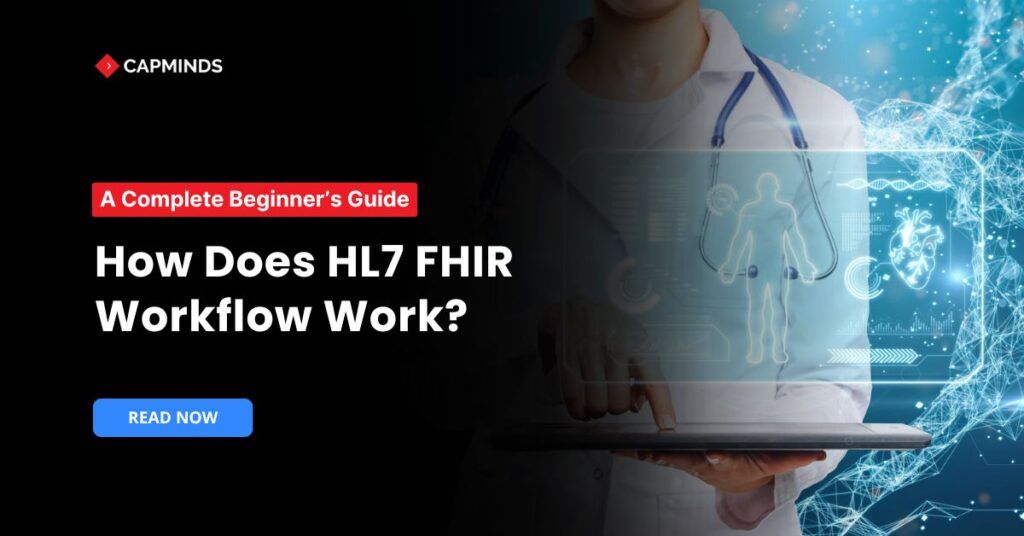How Does HL7 FHIR Workflow Work? A Complete Beginner’s Guide
Sharing healthcare data between systems can be complex and challenging. However, HL7 FHIR simplifies the process with a modern data-sharing approach. It helps different healthcare systems communicate and exchange patient information easily.
If you’re new to FHIR, understanding its workflow is very important. In this blog post, we have shared about HL7 FHIR, the core components, and the common FHIR workflows in healthcare.
What is HL7 FHIR?
HL7 FHIR is a standard for sharing healthcare data efficiently. It was created by HL7 to improve medical data exchange. This system allows hospitals, clinics, and apps to share information. It ensures secure and fast communication between healthcare providers and patients.
FHIR is built using modern web technologies for better compatibility. It includes RESTful APIs, JSON, and XML to handle medical data. These technologies make software integration simpler for healthcare application developers. As a result, electronic health records are shared more effectively.
FHIR has various key features, which include:
- Uses small and reusable building blocks called “resources” to represent clinical and administrative data.
- Supports RESTful APIs which makes it easy for developers to integrate with existing healthcare applications.
- Ensures seamless communication between different healthcare systems.
- Can be used by small clinics, large hospitals, and even mobile health applications.
- Enables instant access to patient data, improving decision-making and care coordination.
FHIR is widely adopted by healthcare organizations, EHR vendors, and regulatory bodies. Including the Office of the National Coordinator for Health IT in the U.S., It plays a crucial role in enabling modern healthcare innovations such as patient portals, telemedicine, and remote patient monitoring.
Why is Interoperability Important in Healthcare?
Interoperability allows different healthcare systems to share patient data easily. It helps doctors, hospitals, and clinics access accurate records without delays. It enables healthcare providers to make quicker and more informed medical decisions. This way, patients will receive safer treatments and better overall care.
Without interoperability, patient data stays scattered across separate, disconnected systems. This often causes delays, missing records, and serious medical errors.
Healthcare providers may struggle to get complete access to patient histories. As a result, mistakes in diagnoses and incorrect treatments can happen.
Related: HL7 FHIR vs. Traditional Data Standards: Why Interoperability Matters
Core Components of FHIR
FHIR includes key parts that help share medical data efficiently. These parts allow hospitals, clinics, and apps to connect easily. Utilizing it, healthcare providers can access patient records quickly without unnecessary delays. So that communication between providers improves, and patient care becomes much better.
1. Resources
Resources are small data units that store important medical details. They include patient records, prescriptions, allergies, and laboratory test results. Systems share only the required data without extra information.
2. RESTful APIs
RESTful APIs help healthcare systems send and receive data easily. They use standard web methods like GET, POST, and DELETE. With these, systems connect smoothly without needing difficult custom coding.
3. Interoperability Layers
FHIR sets clear rules that guide systems in sharing data. It ensures different platforms follow the same formats and standards. So the hospitals and clinics exchange information without compatibility problems.
4. Security and Authorization
FHIR includes strict security measures to protect patient medical records. It supports encryption, authentication, and access control for safe sharing. So, only authorized users can access sensitive health data. This ensures that patient privacy remains secure across different systems.
5. Standardized Medical Terms
FHIR follows global standards to keep medical terms clear and uniform. It supports SNOMED CT, LOINC, and ICD-10 for classifications. Doctors and hospitals use the same terminology correctly. This prevents confusion and ensures accurate treatment decisions for patients.
FHIR’s core components make healthcare data sharing simple and secure. They improve efficiency, protect patient privacy, and enhance provider communication. This results in medical care becoming faster, safer, and more reliable.
FHIR Supports Health Interoperability Paradigms
1. RESTful API-based interactions
FHIR helps different healthcare systems share and access patient data efficiently. It uses RESTful APIs, which allow secure communication between applications. These APIs work over the internet, making data exchange seamless.
- RESTful APIs act as a universal bridge between healthcare systems.
- They enable systems to send, receive, and update patient data quickly.
- This means doctors can access real-time information when treating patients. With this approach, healthcare apps, hospitals, and clinics stay connected.
2. Messaging for structured data exchange
FHIR Messaging helps send structured healthcare data between different systems efficiently. It works by transmitting medical information in a standardized digital format.
This ensures that different healthcare applications can process and use the data. FHIR Messaging follows a structured approach to exchanging healthcare data seamlessly.
- It includes a Message Header that contains essential details. This includes information about the sender and the type of message.
- A Data Payload carries healthcare records, such as lab results. These records may include patient details, appointments, or medical observations.
- A Response Confirmation notifies the sender about message delivery. This ensures that errors or failures can be identified quickly.
3. Document-based data persistence
FHIR organizes medical records using a Composition Resource for structure. This resource helps divide information into sections like symptoms and treatments.
Each section contains specific details about a patient’s health condition. Also, it ensures that the document stays secure and remains unchanged over time.
A Bundle Resource then groups multiple documents for easy access. This ensures doctors can quickly find and review patient histories.
4. Service-based custom workflows
FHIR connects healthcare applications using RESTful APIs for secure data exchange. These APIs help systems request and share patient details in real time. FHIR provides structured resources for managing different healthcare processes.
For example, the Task Resource tracks assignments like lab orders and reports. Meanwhile, the ServiceRequest Resource helps handle referrals, tests, and procedures. By using these tools, healthcare providers automate routine tasks effectively.
Common FHIR Workflows in Healthcare
1. Application-to-application communication
Application-to-application communication allows two or more applications to share information. This process uses Fast Healthcare Interoperability Resources for standard data exchange.
With A2A communication, applications connect to send and receive patient information.
- First, they verify access using OAuth 2.0 and SMART on FHIR. This ensures that only authorized systems can access patient data.
- Next, one system sends a request to another application. The request follows FHIR standards for clear and organized data sharing.
- Then, the receiving system processes the request and gathers relevant details.
- After that, it sends the requested data back to the first system. Finally, the information is stored or displayed for further use.
Related: HL7 FHIR Patient Consent Forms: The What, Why, and How to Integrate OAuth 2
2. Patient data access and engagement
Patients need easy and secure access to their health information.
Patient Data Access and Engagement is a key FHIR workflow. It allows patients to view, manage, and share their medical records. Healthcare applications use FHIR APIs to provide patient-friendly data access.
- Patients log into a secure portal or mobile app. They authenticate using OAuth 2.0 or SMART on FHIR. This ensures that only authorized users can access sensitive health data.
- The application requests medical records from an EHR system. The EHR retrieves and sends patient information in a structured format.
- Patients can then view details like diagnoses, prescriptions, and lab results. They can also share their records with other providers or family members.
3. Linking multiple EHR systems
Healthcare providers often use different Electronic Health Record systems.
Linking multiple EHRs allows seamless data sharing across healthcare organizations. FHIR enables different EHRs to exchange patient data securely.
- Each system verifies access using OAuth 2.0 authentication. This ensures that only authorized users and systems can share data.
- EHR sends a request for patient information. The receiving EHR processes the request and retrieves relevant records.
- Then, the requested data is formatted using FHIR resources like Patient, Observation, and MedicationRequest.
- The data is shared and integrated into the requesting system. This process allows real-time access to up-to-date patient records.
4. Vendor-neutral data storage
Healthcare data is often stored in proprietary systems that limit access.
Vendor-neutral data storage solves this issue by enabling open, standardized storage. FHIR provides a standardized way to store and retrieve patient data.
- Healthcare systems convert records into FHIR resources like Patient, Observation, and MedicationRequest. These resources follow a common structure, ensuring compatibility across systems.
- The data is stored in a vendor-neutral repository rather than a proprietary database. This repository supports FHIR APIs, allowing authorized applications to access the data.
- When a system requests patient information, the repository retrieves and delivers structured data.
This process ensures healthcare providers can access data regardless of the original system.
CapMinds HL7 FHIR Service for Healthcare Practice
CapMinds offers the best all-in-one health interoperability solution for healthcare practices. Our HL7 FHIR service will understand your clinical needs and requirements to cater to our solution.
We have years of experience in this field faced many challenges and tackled them with ease. Why can CapMinds be your Go-to Interoperability Solution?
- We are experienced professionals with years of experience in the field.
- Our technical team is an expert who will analyze your healthcare practice thoroughly to tailor the Interoperability solution.
- We prioritize safety, security, encryption, and authentication to protect your healthcare practice’s patients’ data.
- Our comprehensive solution ensures seamless interoperability, adhering to industry standards and using standard protocols.
- We offer comprehensive training sessions to healthcare staff.
- Our affordable health interoperability solution benefits healthcare practices at all levels.
If you are searching for the best interoperability service for your practice, CapMinds is your choice. We can assist you by navigating all potential challenges and ensuring seamless health data exchange.
Reach out to CapMinds Health Data Exchange Solutions for your Healthcare Practice.




